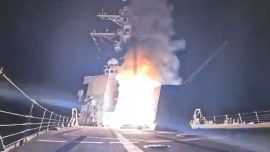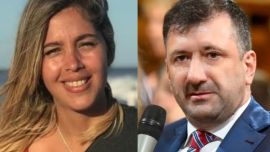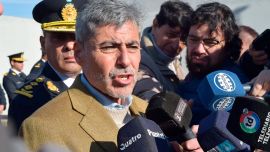October 27, 2010 was a special day, sunny in Argentina: it had been nine years since the last census and everyone was paying attention, peering through the window, waiting the census taker to reach their homes.
Yet some unexpected news changed everything and turned human fragility into the headline of the day. Former president Néstor Kirchner had died at 9:10 am, of “sudden death”, at 60 years old. Or perhaps it had been at 9:15 am, but the difference between the medical report and the official report does not matter much now.
“At quarter past nine former president Néstor Carlos Kirchner died as a result of a non-traumatic cardiac arrest, which did not respond to resuscitation manoeuvres” the official wire written from the data provided by Doctors Renato Lestard and Buonomo, physicians of the Presidential Unit.
“Murder, assasination, terrorist attack?”, the public wondered, in an attempt to find an explanation for the shock of the day. But no, the former president had suffered different cardiac episodes, including a heart attack, and the night of Saturday September 11, forty-seven days before he died, he had undergone a coronary angioplasty. He had been receiving regular medical care ever since, both at his home and in hospital.
Néstor Carlos Kirchner died in his bed in El Calafate, in his home province of Santa Cruz. He was dressed in his best suit and his body was placed in the presidential coffin, made of cedar and with bronze fittings, which had been commissioned to a historical funeral home in Río Gallegos.
“He was lying in bed with light-blue pyjamas. The presidential physician administered cardiac massages, but the device recording heart activity gave no signs. I lifted his eyelids, looked at the pupils: he had total bilateral mydriasis. That’s how I knew he was already dead”, Dr. Claudio Cirille, the doctor on call who arrived in the emergency ambulance to take care of the chief executive before 8 am, told sometime later.
He was no longer alive, but hoping perhaps science could return him from death. Doctors got him in a car and moved him promptly to Hospital Formenti, El Calafate. His wife, Cristina Fernández, her secretary and presidential security followed them in another vehicle.
Cristina Fernández de Kirchner was then in the middle of the first of her two consecutive terms in office.
Kirchner was intubated, put on a drip, applied the defibrilator three times and administered cardiac massages, but nothing worked. He could not be brought back to life.
Cristina did not leave his side –doctors had asked her to stay outside the accident and emergency room, but it was no use and they did not dare insist. She asked, practically ordered them to do more, then they applied a further adrenaline shot to the patient. There was nothing more to be done. And crying overcame everything.
Cristina embraced the lifeless body of the man who had been her husband for 35 years, the father of her children, Máximo and Florencia. Her head was a whirlwind of grief and bewilderment. Even so, she actually asked Pablo Barreiro, her private secretary to go get her deeply trusted housekeeper, María Angélica “Cuca” Bustos and take her to the hospital.
That very night, his body was moved to Buenos Aires and the wake would be at Casa Rosada.
When they looked at each other, Cuca and Cristina instantly hugged and in tears, the Vice President asked her to please dress Néstor in “his best clothes”. Cuca did so, with the help of Pablo Barreiro and his father, Ricardo, “the gardener”.
One of his physicians, Renato Lestard, confirmed that his body had no signs of physical violence, but did not order an autopsy, at his wife’s request, since Article 264 of the Criminal Procedure Code provides that the autopsy is mandatory “in any case of violent death or suspected criminality”.
This decision fed rumours and suspects on the cause of death, but it was all dispelled when journalist Ceferino Reato, who had interviewed him a few days before his death revealed that Kirchner had told him: “I’m the next president, unless I die first”.
One journalistically curious thing was that, on the same day, a journalistic team from Editorial PERFIL, consisting of reporter Nicolás Diana and photographer Eduardo Lerke had arrived in El Calafate to investigate the real estate deals the presidential family had in the province, give an account of the Hotel Alto Calafate from the inside and report on the presidential day during the census.
“The minute we arrived, we noticed a strange atmosphere. Tense”, remembered Diana, a decade later. And he added: “At some point the gate opened, a security came out shouting. He told a policeman to call the head of security now. It’s urgent. He looked at us and said: ‘get these two out of here’”, the accredited journalists then said, who, by then, did not have any idea what was going on.
Until a contact of the ex president, from El Calafate, helped him out: “‘Néstor’s dead, go to the hospital”, he told Diana on the phone.
“The hospital was chaos. We parked the car, got out and two officers shouted at us to stay 200 metres behind. We stayed anyway”, Diana told some time later. “We were there for nearly 50 minutes, until at some point from one of the exits of the hospital a mini caravan came out with Kirchner’s body. An ambulance and six vans, Cristina was riding in the passenger seat of one of them”.
A few minutes later other Kirchners arrived, Máximo and Alicia, and figures from their circle such as Rudy Ulloa and Julio de Vido. Lázaro Báez also popped by, saying: “One of my brothers has died”.
The memorial service of ex-president Kirchner lasted over three days, until October 30, His coffin was placed at the Hall of Latin American Patriots, serving as a funeral chapel. Multiple citizens and personalities from local and international politics approached to say goodbye to his remains and give condolences to his family.
As had been the case in the funeral of two other noteworthy former presidents, Juan Domingo Perón (1974) and Raúl Alfonsín (2009), it was raining in Buenos Aires, but the water did not scare the hundreds of thousands of mourners who wanted to say goodbye in person. Other thousands followed the grief on television, broadcast live 24 hours a day.
“Argentina has lost a gladiator, who got angry, who always got us out of the hole and was respectable in all concerns”, said Diego Armando Maradona as he left the hall.
At 1 pm on October 30, his coffin wrapped in an Argentine flag was moved in a funeral procession to Aeroparque airport. The caravan and crowd were so large that the vehicle took 70 minutes to get there. People said goodbye as it went by with different banners to support the widow: “Courage, Cristina!”, “Néstor, the people are with you”, “Re-election for Cristina”.
An Airforce plane took him to Río Gallegos, his final resting place.
After October 27, 2010 and for several nights, Cristina asked Cuca to sleep with her in her room, because she could not sleep.
After his death, Cristina was in strict mourning for nearly two years.
Néstor Kirchner was born on February 25, 1950, in Río Gallegos. At the time of his death, he had been a deputy for Buenos Aires Province since 2009.
When the military dictatorship started, the Kirchner marriage moved to Río Gallegos, in mid 1976. They opened a law firm, and in 1981, the couple and Alicia Kirchner founded the Ateneo Juan Domingo Perón. In 1982, the basic unit Los Muchachos Peronistas, which was their platform to aspire to the mayoralty of Río Gallegos (1987-1991), after the return to democracy, in 1983.
Néstor Kirchner was a Governor of Santa Cruz (1991-2003) and President of Argentina (2003-2007).


















Comments